Table of Contents
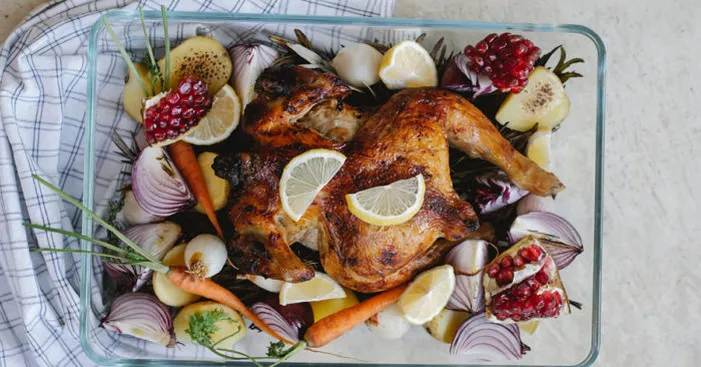
Have you ever wondered what is the value of a whole chicken calories?
Chicken is the most consumed meat in the US, according to the US department for agriculture!
Not only is it more consumed than other red meats, but it’s also cheaper and in most cases richer in nutrients!
No wonder why you easily find chicken in almost every diet, as it’s rich in protein, vitamins, and minerals.
Compared to the ’50s, a modern chicken is 3 times larger, which is more efficient at transforming feed into the breast meat. (1)
Did you know that chicken has fewer calories than pork, beef, and turkey?
With a low-calorie intake, it still holds on to many nutrients and has major health benefits.
In this article, I am going to break down all of the information I found while researching about chicken, including general information about chicken meat, whole chicken calories, how to buy & cook & store chicken meat, alongside the precautions you need to know before consuming chicken meat.
Is chicken considered meat?
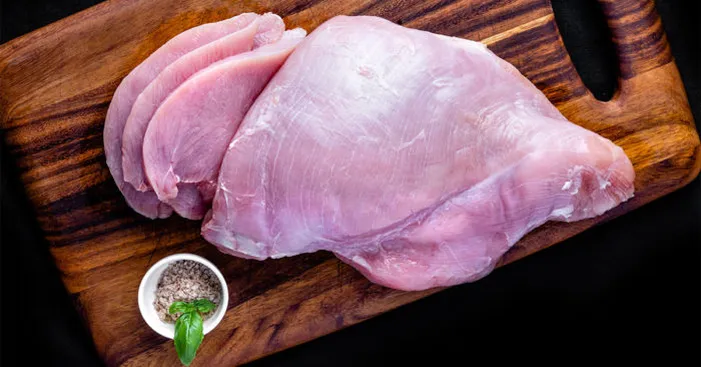
Yes! Just like turkey, beef, pork, and every other meat, chicken is considered meat.
Meat is by definition a muscle tissue or flesh.
That definition also includes shrimp and fish.
Few people would agree, but every animal flesh we eat can be called meat whether it’s beef, fish, pork, lobster … or chicken!
Woody chicken:

Usually, it is more common in chicken breasts.
Woody chicken is basically a muscle abnormality that causes the meat to be pale in color, rubbery and poor in texture. (2)
However, that does not represent any health concern and has no negative impact on the whole chicken.
Even though causes are still unknown, many theories are being researched including genetics of the birds, breeding processes, fast-growing poultry industries …
But one cause we can agree on is: overcooking!
When cooking chicken, make sure there is some kind of isolation, by cooking it in a sauce, keep the skin intact and only remove it after cooking or cover it with aluminum foil!
Another useful tip is to make sure the temperature doesn’t exceed 165 Fahrenheit, as that is the recommended degree for a chicken to be cooked properly. (3)
Whole chicken calories:
A whole chicken is usually between 3 and 8 pounds, and it includes 2 breasts, 2 wings, 2 whole legs (thighs and drumsticks), and neck & giblets.
It includes both dark and white meat and can be consumed to lose or gain weight, depending on the way you cook it and the parts you eat.
An average 4 pounds chicken, with skin and bones you get: (4)
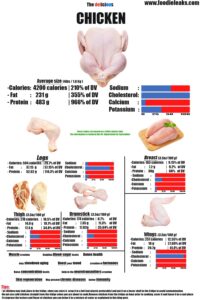
- Calories: 4200 calories 210% of DV
- Fat: 231 g and 355.38% of DV
- Protein: 483 g and 966% of DV
- Sodium: 61.25% of DV
- Cholesterol: 525% of DV
- Calcium: 8.64% of DV
- Potassium: 41.37% of DV
These values are based on a 2000 calories diet. The information is found in the US. Department for Agriculture website. (5)
Assuming that you won’t be eating chicken for breakfast, and as nutrition experts suggest that the average caloric intake for lunch and dinner should be between 500 and 700 calories.
That means a whole chicken can serve up to 6 people per meal.
Cooking chicken:
Cooking chicken in the oven:

Baked chicken is a delicacy throughout the world and is almost present in every cuisine from West to East.
To obtain a golden crispy skin start by massaging the raw chicken with butter or olive oil and any herb of your choice.
While baking, chicken releases their oil so don’t forget to marinate them with their own juice every 15 minutes.
In case the chicken is a little dry and doesn’t release much juice, it’s not necessarily a bad sign, just pour a cup of water or chicken broth into the oven tray to marinate it.
As for the cooking time, you can follow a very simple rule: 1h for each 2lbs (1Kg), so a 3 pounds chicken would need 1h and 30 minutes.
Preheat your oven at 480°F (250°C) and use the same temperature for the first 15 minutes, then drop it to 390°F (200°C) for the rest of the cooking.
Cooking chicken casserole:
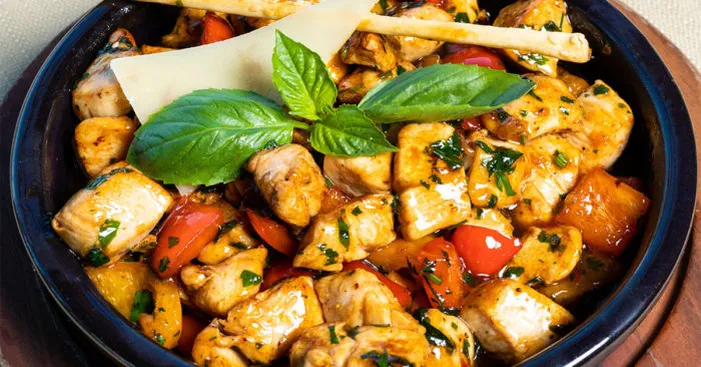
When the chicken, whole or into pieces, simmering in a pot it doesn’t risk drying out as the steam produced by the chicken remains in the pot.
As a result, the chicken meat keeps its tenderness and juiciness after cooking.
Now for the cooking time, you can use the same rule for baking (1h for each 2lbs).
Furthermore, the best ingredients that combine well with chicken meat you could use onions, garlic, rosemary, and any herb of your choice.
Also, you can use more spices like paprika, ground black pepper, salt, cumin and olive oil, and anything you like to use for seasoning.
You can cook chicken casserole on a closed pot using a kitchen radiator or oven as it won’t make a difference as long as the pot is locked.
Cooking chicken in the microwave:

Yes, you can cook chicken in a microwave, and of course, this only counts for small chicken parts and not a whole chicken.
However, a chicken part cooked in a microwave doesn’t have the same properties as a baked/roasted chicken.
Nonetheless, it will result in much juicier and more tender meat.
To try that:
- Get a freezing bag and put a chicken breast or a chicken leg inside then add 2 tbsp of water and any seasoning of your choice.
- Then, close the freezing bag, shake it well so all the ingredients mix together then place it in the microwave.
- Usually, it takes about 30 to 40 minutes for the chicken part to be done.
This method may be perfect in case you’re in a hurry and don’t have time for cooking as it takes no time to prepare.
Pan-frying chicken:
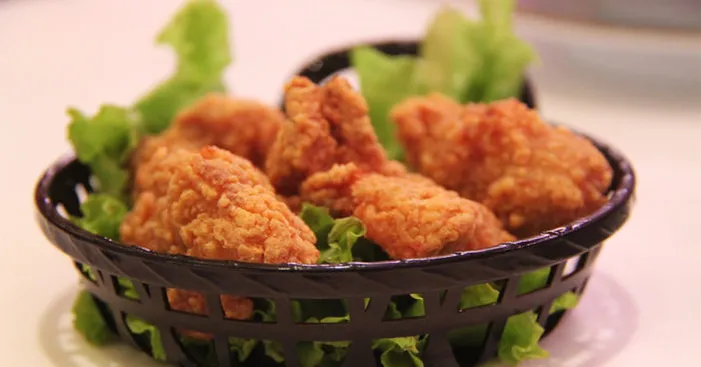
This is the quickest cooking technics for chicken just ensure you cut the chicken in pieces to guarantee that there is no rareness left inside.
Nonetheless, make sure you stand next to the pan during the entire process and not let the chicken pieces dry out.
In case you are cooking the chicken with vegetables, start by frying the vegetables first.
Afterward, replace them with the chicken pieces and finish by adding the vegetables again in the pan towards the end of cooking.
Serve the fried chicken alongside the vegetables and curry paste diluted in coconut milk or a dash of cream.
Steaming chicken:
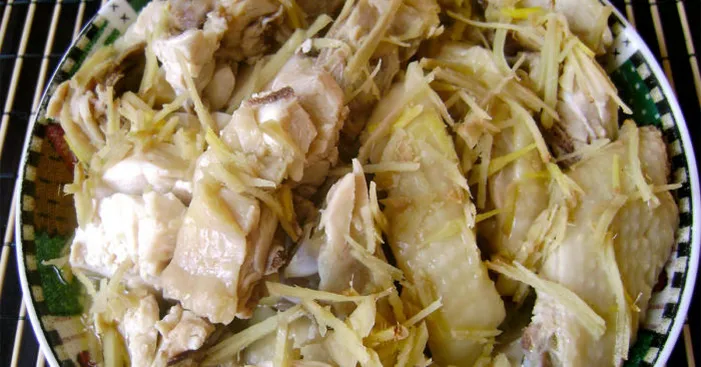
Steaming chicken is not just a quick-cooking method but it is also the best one to preserve most of the chicken nutrients.
Also, your chicken will never go dry when you steam it.
However, steaming chicken is not very much appreciated as it is considered among the “bland” cooking technics.
Although, you can use aromatic herbs and spices in your steamer basket or wrap them in a sealed bag with the chicken.
Usually, it takes between 20 to 30 minutes to steam a chicken piece (leg, breast …).
Precautions before you consume chicken calories:

Chicken meat is generally very safe to eat and actually healthier than most types of meat including beef, lamb, and pork.
However, whole chicken calories are probably too high for one person to eat alone and definitely would have side effects.
Also, raw chicken is more vulnerable to bacterial growth which may lead to food poisoning.
Among the bacteria in raw chicken meat it may contain:
Campylobacter:
These bacteria cause infection mainly in the fragile intestines and result in food poisoning.
The symptoms of campylobacter infection appear between 5 and 7 days after infection, and maybe: (6)
- Fever.
- Vomiting.
- Abdominal pain.
- Diarrhea.
Salmonella:
Infections from salmonella in raw chicken meat usually lead to inflammation of the intestines and the stomach (gastroenteritis).
The period between getting the first infection from salmonella and actually get poisoned varies from few hours to 4 or 7 days. (7)
Among the symptoms of salmonella infection:
- Abdominal pain.
- Fever.
- Nausea.
- Diarrhea.
- Headaches.
- Bloody defecation.
These symptoms may stay for up to 10 days and the intestines usually need several months to completely get completely healthy.
Clostridium perfringens:
These bacteria may exist in all types of meat and they could remain even after cooking.
Hence, it is healthier to cook chicken meat with a temperature of at least 165°F (73°C) and serve them no longer than 2 hours after cooking. (8)
As for the symptoms of Clostridium perfingens, they can be in the form of:
- Inflammation of the intestines.
- Diarrhea.
- Stomach cramps.
- Vomiting.
- Fever.
However, these bacteria in raw chicken have a very low fatality rate and only occur if the symptoms remain for more than 10 days without treatment.
Buying chicken:
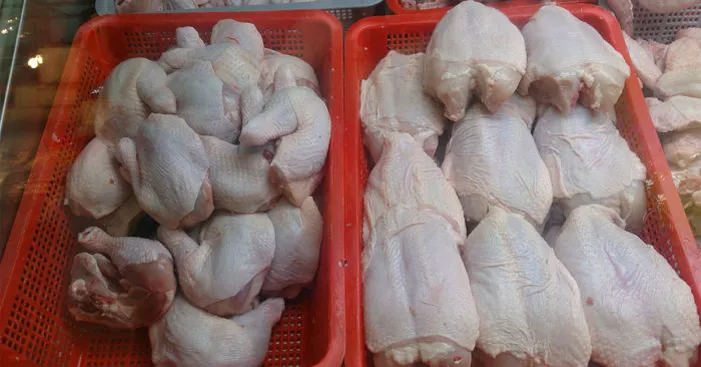
When you are buying a chicken, there are few tips that you need to know in order to ensure the best quality.
First, a chicken should always weigh its weight, in other words, this means the chicken should always weigh more than 3lbs (1.5Kg).
If the chicken weighs less than 3lbs, it means that it was either badly fed or slaughtered too early.
The next thing you should look into is the bones, strong chicken bones are a sign that the bird grew naturally in open farms.
Also, a well-fed chicken tends to have better quality meat that is firm and stays attached to the bones even after cooking.
If the meat is dry, the bone structure is weak or the bones are cracked after cooking, do not buy your chicken from the same buyer.
In malls and grocery stores, there are different labels that could give you a good indication of the quality of the meat.
Among those labels you may find: (9)
- “Antibiotic-Free”
- “Natural”
- “Hormone-Free”
- “Organic”
If you want to keep things simple, always go for “organic” chicken, this means they are fed according to the USDA recommendation. (10)
However, “natural” chicken means nothing as it only applies to the meat processing after slaughtering the chicken.
Thus, a “natural” chicken doesn’t have anything to do with the way the birds were grown or the type of food they got.
“Antibiotic-free” is a good indicator and means that the chickens didn’t need antibiotics to prevent diseases which means they had good living conditions.
“Hormone-free” is just a marketing technique as it applies to every chicken in the US as the law prohibits hormonal treatment.
Storing chicken:

Since chicken meat requires a short time to cook, you can find it in almost every refrigerator or freezer.
However, the shelf life of chicken meat depends on the storage methods.
Storing chicken in the refrigerator:
You can store raw chicken meat in the refrigerator for up to 2 days.
In order to extend its lifespan, make sure you place it on the coldest shelf of the refrigerator with a temperature lower than 40°F (4°C).
Also, do not wash chicken meat before you store it because that would result in the spread of bacteria across the whole meat.
Instead, only wash the parts of the chicken 1 hour before using them.
Storing chicken meat in the freezer:
You can freeze a whole chicken or even parts of a chicken, however, it is probably better to cut the chicken to save more space.
By cutting the chicken, you will have more freedom in rearranging the parts of the chicken to save maximum space.
First, remove the gibbets of the chicken and all of the inside parts and only keep the liver as it has a wonderful taste and less risk of bacterial growth.
Then, cut the chicken into pieces and wrap them entirely or separately with aluminum foil before you place them in a bag.
Ideally, it is better if you use a freezing bag, if not you can use any airtight sealing bag just make sure you vacuum it from the air.
Frozen chicken meat at a temperature of 0°F (-18°C) may remain edible for 12 months. (11)
If you bought many chicken liver and want to freeze them you can use the same technic and they will remain edible for 3 months.
Freezing cooked chicken meat:
It is possible to freeze cooked chicken whether they are in a stew or just grilled or cooked in the oven.
Nonetheless, there are few tips you need to know to ensure the tastiness of the chicken remains the same after freezing.
First, debone the chicken and remove all access fats as those parts tend to spoil faster and this may affect the taste and healthiness of the chicken.
Also, try to avoid the use of too much salt as that will slow the freezing process.
Using a plastic air-tight container, you can freeze your cooked chicken meat for up to 6 months.
When the time of consumption comes, place your frozen chicken meat (raw or cooked) in the refrigerator.
That will ensure a smooth thawing unlike thawing chicken at room temperature which is favorable for bacterial growth.
However, if you are in a hurry you can place the frozen chicken in a microwave for few minutes (5 minutes) and then use them.
How do you know if chicken meat is still good for consumption?
Regardless of the storing process, chicken meat needs to be consumed quickly after being exposed to room temperature.
Nonetheless, if you are not sure of the freshness of the chicken you can use these tips:
If you are dealing with raw chicken:
- The first thing is to ensure that the meat is still pink and not grey.
- Secondly, the smell of rot raw chicken is usually unbearable and very unpleasant if that is the case you should throw it away.
If you are dealing with frozen raw chicken:
Use the first two technics to ensure the meat is not grey neither has a strong unpleasant smell.
The meat must not have many layers of ice as that layer is made with spoiled material, therefore the chicken is no longer edible.
If you are dealing with cooked chicken:
Pay attention to the color of the chicken as it shouldn’t be grey either have any traces of mold, if you find any, throw the chicken away.
Tips:
Many famous Chefs including Chef Thomas Keller suggest to brine chicken meat in order to obtain a moist wet cooked meat. (12)
Here are simple steps you can use to brine chicken:
- Make a mixture of 1 gallon water, salt, garlic, peppercorns, thyme, parsley, rosemary, bay leaves. (You may add some honey).
Heat the mixture for up to 4 minutes until the salt dissolves. - Take the mixture off the heat and let it cool.
- Submerge the chicken completely in the mixture.
- Cover the pot and place it in the refrigerator for 12 hours.
- Remove the chicken, rinse it with cool water then dry it.
Now you can proceed with whatever cooking method you desire. You’ll notice a huge difference in texture, more juicy and buttery than you ever experienced, Enjoy it !!
References:
(1): Chickens have gotten ridiculously large since the 1950s – Vox
(2): What is woody breast? (chickencheck.in)
(3): Cooking Meat? Check the New Recommended Temperatures | USDA
(4): How Much Do Chickens Weigh? (With 17 Examples) (beyondthetreat.com)
(5): Nutrition Facts – Chicken & Turkey (usda.gov)
(6): Campylobacter – StatPearls – NCBI Bookshelf (nih.gov)
(7): Salmonella Infections: MedlinePlus
(8): Clostridium perfringens | UNL Food
(9): Understanding Poultry Labels – The Real Food Dietitians
(10): Organic | Agricultural Marketing Service (usda.gov)
(11): 2018-03-06-FoodStorageCharts-English (fda.gov)
(12): Chef Thomas Keller’s Chicken Brine Recipe – 2021 – MasterClass
